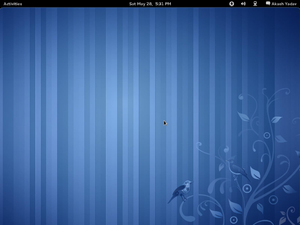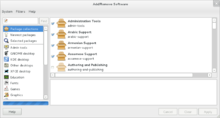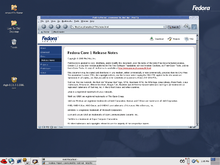| LinuxPlace.net the Linux Place on the Net |
Fedora operating system
By Wikipedia, the free encyclopedia
http://en.wikipedia.org/wiki/Fedora_%28operating_system%29
Fedora (pronounced /fɨˈdɔːrə/) is a RPM-based, general purpose collection of software, including an operating system based on the Linux kernel, developed by the community-supported Fedora Project and sponsored by Red Hat. The Fedora Project's mission is to lead the advancement of free and open source software and content as a collaborative community.
One of Fedora's main objectives is not only to contain software distributed under a free and open source license, but also to be on the leading edge of such technologies. Fedora developers prefer to make upstream changes instead of applying fixes specifically for Fedora—this ensures that their updates are available to all Linux distributions.
Compared to more main stream Non-Linux operating systems Fedora has a short life cycle. Version X is maintained until one month after version X+2 is released. With 6 months between releases, the maintenance period is a very short 13 months for each version. This can lead to trouble should one wish to use a particular version of Fedora for product development (i.e., embedded systems) where long term support is more important than maintaining leading edge revisions of software.
In 2008, Linus Torvalds, author of the Linux kernel, stated that he used Fedora because it had fairly good support for the PowerPC processor architecture, which he favored at the time.
According to DistroWatch, Fedora is the third most popular Linux-based operating system as of June 2011, behind Ubuntu and Mint, and it is the most popular RPM-based Linux distribution.
Slackware aims for design stability and simplicity, and to be the most "Unix-like" Linux distribution, making as few modifications as possible to software packages from upstream and using plain text files and a small set of shell scripts for configuration and administration.
History
The Fedora Project was created in late 2003, when Red Hat Linux was discontinued. Red Hat Enterprise Linux was to be Red Hat's only officially supported Linux distribution, while Fedora was to be a community distribution. Red Hat Enterprise Linux branches its releases from versions of Fedora.
The name of Fedora derives from Fedora Linux, a volunteer project that provided extra software for the Red Hat Linux distribution, and from the characteristic fedora used in Red Hat's "Shadowman" logo. Warren Togami began Fedora Linux in 2002 as an undergraduate project, intended to provide a single repository for well-tested third-party software packages so that non-Red Hat software would be easier to find, develop, and use. The key difference between the approaches of Fedora Linux and Red Hat Linux was that Fedora's repository development would be collaborative with the global volunteer community. Fedora Linux was eventually absorbed into the Fedora Project, carrying with it this collaborative approach. Fedora is a trademark of Red Hat, and although this had previously been disputed by the creators of the unrelated Fedora repository management software, the issue has now been resolved.
The Fedora Project is governed by a board whose majority is elected by the Fedora community.
Features of Fedora
Distribution
The Fedora Project distributes Fedora in several different ways:
- Fedora DVD/CD set – a DVD or CD set of all major Fedora packages at time of shipping;
- Live images – CD or DVD sized images that can be used to create a Live CD or boot from a USB flash drive and optionally install to a hard disk;
- Minimal CD – used for installing over HTTP, FTP or NFS.
The Fedora Project also distributes custom variations of Fedora which are called Fedora spins. These are built from a specific set of software packages and have a combination of software to meet the requirements of a specific kind of end user. Fedora spins are developed by several Fedora special interest groups. It is also possible to create Live USB versions of Fedora using Fedora Live USB creator, UNetbootin or dd.
Extra Packages for Enterprise Linux (EPEL) is a volunteer-based community effort from the Fedora project to create a repository of high-quality add-on packages that complement the Fedora-based Red Hat Enterprise Linux and its compatible spinoffs such as CentOS or Scientific Linux.
Software package management is primarily handled by the yum utility. Graphical interfaces, such as pirut and pup are provided, as well as puplet, which provides visual notifications in the panel when updates are available. apt-rpm is an alternative to yum, and may be more familiar to people used to Debian or Debian-based distributions, where Advanced Packaging Tool is used to manage packages. Additionally, extra repositories can be added to the system, so that packages not available in Fedora can be installed.
Software repositories
Fedora comes installed with a wide range of software that includes LibreOffice, Firefox, Empathy, Evolution and GIMP. Additional software that is not installed by default can be downloaded using the package manager.
Before Fedora 7, there were two main repositories – Core and Extras. Fedora Core contained all the base packages that were required by the operating system, as well as other packages that were distributed along with the installation CD/DVDs, and was maintained only by Red Hat developers. Fedora Extras, the secondary repository that was included from Fedora Core 3, was community-maintained and not distributed along with the installation CD/DVDs. Since Fedora 7, the Core and Extras repositories have been merged, hence the distribution dropping Core from its name. That also allowed for community submissions of packages that were formerly allowed only by Red Hat developers.
Also prior to Fedora 7 being released, there was a third repository called Fedora Legacy. This repository was community-maintained and was mainly concerned with extending the life cycle of older Fedora Core distributions and selected Red Hat Linux releases that were no longer officially maintained. Fedora Legacy was shut down in December 2006.
Third party repositories exist that distribute more packages that are not included in Fedora either because it does not meet Fedora's definition of free software or because distribution of that software may violate US law. The primary third party repositories, and the only fully compatible ones, are RPM Fusion and Livna. RPM Fusion is a joint effort by many third party repository maintainers. Livna is still maintained separately as an extension of RPM Fusion for legal reasons and only hosts the libdvdcss package for encrypted DVD playback.
Security features
Security is one of the most important features in Fedora. One of the security features in Fedora is Security-Enhanced Linux, a Linux feature that implements a variety of security policies, including mandatory access controls, through the use of Linux Security Modules (LSM) in the Linux kernel. Fedora is one of the distributions leading the way with SELinux. SELinux was introduced in Fedora Core 2. It was disabled by default, as it radically altered how the operating system worked, but was enabled by default in Fedora Core 3 and introduced a less strict, targeted policy.
Releases
| Color | Meaning |
|---|---|
| Red | Release no longer supported |
| Green | Release still supported |
| Blue | Future release |
| Project Name | Version | Code name | Release date | Kernel version |
|---|---|---|---|---|
| Fedora Core | 1 | Yarrow | 2003-11-05 | 2.4.19 |
| 2 | Tettnang | 2004-05-18 | 2.6.5 | |
| 3 | Heidelberg | 2004-11-08 | 2.6.9 | |
| 4 | Stentz | 2005-06-13 | 2.6.11 | |
| 5 | Bordeaux | 2006-03-20 | 2.6.15 | |
| 6 | Zod | 2006-10-24 | 2.6.18 | |
| Fedora | 7 | Moonshine | 2007-05-31 | 2.6.21 |
| 8 | Werewolf | 2007-11-08 | 2.6.23 | |
| 9 | Sulphur | 2008-05-13 | 2.6.25 | |
| 10 | Cambridge | 2008-11-25 | 2.6.27 | |
| 11 | Leonidas | 2009-06-09 | 2.6.29 | |
| 12 | Constantine | 2009-11-17 | 2.6.31 | |
| 13 | Goddard | 2010-05-25 | 2.6.33 | |
| 14 | Laughlin | 2010-11-02 | 2.6.35 | |
| 15 | Lovelock | 2011-05-24 | 2.6.38 | |
| 16 | Verne | 2011-11-08 | 3.1.0 | |
| 17 | Beefy Miracle | May 2012 |
Derivatives
- Active Fedora Derivative Linux Distributions:
- Berry Linux – a medium-sized Fedora based distribution that provides support for Japanese and English.
- BLAG Linux and GNU – a stripped down 1-CD Fedora with Debian's APT system.
- Ekaaty Linux – from Brazil.
- Fuduntu - Optimized for netbooks, development headed by Jupiter creator Fewt.
- Fusion Linux - Fedora Remix oriented more for Desktop users and usability, uses Linux Mint as model
- MythDora – based around MythTV's media center capabilities.
- Ojuba Linux - an Arabic Linux distribution.
- Omega - Rahul Sundaram, Red Hat's Community Engineer, has created a Fedora remix with full multimedia support including MP3 and DVD playback support by adding software from RPM Fusion and Livna software repositories by default.
- Red Hat Enterprise Linux – enterprise Linux offering from Red Hat, which branches from the current Fedora baseline.
- PLS Linux Version of Fedora, designed and developed in Venezuela, which has a high performance client-server solutions, used by the Public Administration (Government of Venezuela).
- Russian Fedora Remix - version of Fedora, adapted for Russia. Contains proprietary drivers and software.
- Xange – (formerly Simplis and Vixta) is an easy-to-use, Fedora-based desktop Linux distribution featuring the KDE desktop.
- Moblin – a distribution mainly for MIDs, netbooks and embedded devices.
- Not active (no release for over 12 months):
- ASPLinux – a Russian Fedora based distribution. ASPLinux also includes closed source NVIDIA and ATI drivers, and supports proprietary audio and video codecs.
- Aurora SPARC Linux – for the SPARC platform.
- Eeedora – for the Asus Eee PC, started in 2007
- Fox Linux – made in Italy, designed for basic home computing tasks such as browsing the Web, writing and printing documents, using multimedia and burning discs.
- Linpus - made by Taiwanese company Linpus Technologies for the Asian market.
- Linux XP – a commercial Linux distribution aimed at replacing Windows XP as a home-use desktop operating system.
- Nusantara – a Linux distribution supported by the Indonesian ministry of technology as a desktop operating system.
- Open Discovery - An integrated High Performance Bioinformatics Linux Platform.
- Yellow Dog Linux – for the PowerPC platform.
Source: http://en.wikipedia.org/wiki/Fedora_%28operating_system%29
Published - October 2011
Read all articles at the Linux Place!
All rights reserved © 2011-2024 LinuxPlace.net



